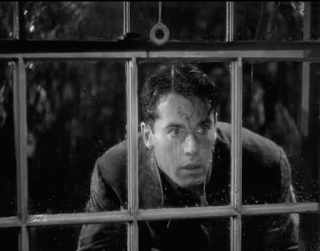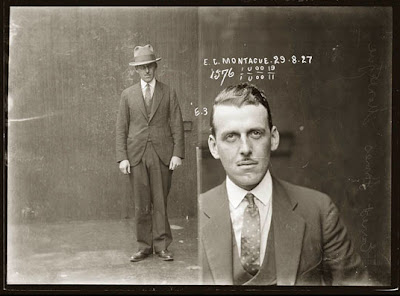 |
| Sylvia Sidney and Henry Fonda in 'You Only Live Once.' |
D
irector Fritz Lang's masterpiece of German cinema, “M” (1931), delves into the murky waters of criminality with an assuredness that few films of that era can match. A frantic search is on for a serial killer who murders children, resulting in an uptick in police raids and harassment of Berlin's illicit enterprises. The police are frustrated in their search for the maniac, so members of the city's underworld, eager to ward off police interference, take matters into their own hands.
The dark, brooding atmosphere of "M," shot in glorious black and white, crossed the Atlantic with Lang when he left his native Europe and came to work in Hollywood. His vision of the shadowy underworld was destined to become part of the fabric of early- to mid-century American cinema in what was later known as film noir — French critic Nino Frank coined the term in 1946.
All of which leads us to a film the director made six years later.
A word of warning here, SPOILERS ABOUND, so you might want to stop reading here if you've yet to see "You Only Live Once" and “M.”
Lang made “You Only Live Once” (1937) in the United States, and it’s based loosely on the exploits of real-life bank robbers Bonnie Parker and Clyde Barrow. In it, the director translates his German Expressionist aesthetics to the American gangster film. As with all of his films, Lang infuses the story with comments on injustices the powerless must face, in this case at the hands of enforcers of the law.
In the opening scene, a prosecutor and a public defender mull over the facts of a case while a fruit peddler complains that a cop on the beat steals apples from his stall. The peddler is shooed away while bureaucrats shuffle papers and bargain over how the law will be enforced. Failing to receive help, the forlorn peddler goes comically livid as a policeman swipes another of his apples right under his nose.
Eddie Taylor (Henry Fonda), a three-time loser, is released from prison and promptly marries his sweetheart, Joan Graham (Sylvia Sidney), who happens to be the public defender’s secretary. It was she who turns a deaf ear to the complaining fruit peddler, but as the story progresses her understanding of the justice system will change significantly.
In the opening scene, a prosecutor and a public defender mull over the facts of a case while a fruit peddler complains that a cop on the beat steals apples from his stall. The peddler is shooed away while bureaucrats shuffle papers and bargain over how the law will be enforced. Failing to receive help, the forlorn peddler goes comically livid as a policeman swipes another of his apples right under his nose.
Eddie Taylor (Henry Fonda), a three-time loser, is released from prison and promptly marries his sweetheart, Joan Graham (Sylvia Sidney), who happens to be the public defender’s secretary. It was she who turns a deaf ear to the complaining fruit peddler, but as the story progresses her understanding of the justice system will change significantly.
On their honeymoon they come upon a frog pond, where Eddie discloses that his first brush with the law came when he roughed up his peers who cruelly tore the legs off of frogs. The honeymooners note that these cold-blooded creatures mate for life. When one dies, the other soon follows — an omen of things to come, perhaps.
 |
| Death row visit. |
What drives the story is Eddie's anger over the small and not so small disparities between the way the well-connected and the downtrodden are treated. He's the victim of foolish choices he made as a youngster, and now society and law enforcers won't let him off the hook.
Set up in a job with a trucking company courtesy of the corrections system, Eddie’s path to redemption quickly turns rocky.
The couple finds a shabby residence, but Eddie's boss fires him for a minor offense. Joan moves into the house without telling Eddie. Reluctant to deliver the bad news, Eddie doesn’t let on that he’s unemployed, but the down payment is due by the end of the week. We see the makings of an alternate plan when he pulls back some bedding to reveal a gun under his pillow.
Last Ditch Effort
 |
| Eddie makes a break for it. |
Turns out, his hat was stolen in a restaurant – it’s the only clue left at the robbery scene – and he is being framed. Joan wants him to turn himself in, but the police find him before he can. Eddie is found guilty and is sentenced to the electric chair.
With Eddie’s criminal record and prison history, the public, the police and prosecutor are quick to believe that he’s the culprit. “Eddie Taylor has been pounding on the door of that execution chamber since he was born,” says one.
Desperation
On death row, he and Joan have their last visit before he is to be executed and he tells her to bring him a gun. She does, but a priest who accompanies her is wise to the charade and quashes the plan. Then, an inmate passes Eddie a note that says there’s a gun stashed in the mattress in the isolation ward.
 |
| Shadows in a cell block. |
A Bold Move
Eddie tears apart a tin cup, cuts his wrist and acts erratically, hoping to be put in isolation. When he’s eventually taken there, he uses the gun to take a doctor hostage and escape.
The warden issues a shoot to kill order, adding that they should save the doctor being held hostage, if possible. The scene cuts to a news ticker tape — the armored car Eddie supposedly robbed has been recovered and evidence shows he is not the guilty party. Authorities issue a pardon for Eddie with a swiftness possible only in the movies. The real killer is Eddie’s former cellmate, Monk.
Of course, Eddie doesn't get the memo, and when he's told that he’s a free man he thinks it’s a ploy to capture him. Father Dolan, the priest who stopped Joan from smuggling the gun, intervenes, but Eddie has lost his faith.
Fog shrouds the prison grounds — another noir touch that reflects Eddie's confused state of mind — and officials are loathe to let Eddie escape with a gun even though he’s been pardoned. He’ll kill the first person he meets, they say. Before he can leave the prison grounds he shoots Father Dolan, his staunchest ally, and manages to get away.
The Fugitives
 |
| Eddie Taylor on the run in 'You Only Live Once.' |
Joan's sister wants to send her to live in Havana, but she hits the road with Eddie instead. It's not long before the law bears down on them and both are wounded.
Troopers pursue them on foot to the edge of the Mexican border, where freedom awaits them, but can they make it?
Eddie carries Joan, just yards from the border, and she expires in his arms. We see the pair lined up in a trooper’s telescopic sites. A blast of gunfire ends their quest for freedom.
A Voice from Beyond
We hear Father Dolan in voiceover, speaking from beyond the grave we must presume. “You’re free, Eddie, the gates are open,” referring to the gates of Heaven, rather than an earthly passageway to freedom.
In contrast, "M" ends on a decidedly pessimistic note. The murderer faces mob justice at the hands of underworld figures who capture him and bring him before a kangaroo court. The criminals are unanimous in calling for the killer’s head. The police and justice system, they say, would be too lenient, likely they will institutionalize him, and there is always a chance that he will escape and kill again. But the police arrive before the criminal element has its way, and the murderer is arrested and brought to trial.
Aside from religiosity, a glaring difference between the two films is that in “You Only Live Once,” American police, courts and prisons are called to task for their rush to judgment and use of lethal force that brings about the demise of Eddie and Joan. As for “M,” charges of law enforcement’s excessive leniency probably reflect a segment of German public opinion between the World Wars.
 |
| Peter Lorre in "M." |
Both films come to tragic conclusions, but each has a distinct difference in tone and outlook. In the blunt closing scene of “M,” mothers of the young murder victims reflect that punishing the perpetrator will not bring back their children.
"You Only Live Once" ends on what some might say is a brighter, if slightly ambiguous, conclusion — Eddie and Joan find redemption in the afterlife. Or, do they?
Director and film historian Peter Bogdanovich asked Lang whether the gates of Heaven ending should be understood as ironic or as the truth, to which Lang replied, "As the truth." He reminded the interviewer that he was raised a Catholic, although admitting, by the church's standards, he was not a good Catholic.
"I think it was the truth for those people," he said. "The doors are open now."
The priest whom Eddie murders, the only prison official who believed in him, is the voice welcoming him and Joan to the Pearly Gates, while the authorities who judged them harshly likely expect the pair to be shunted off to eternal damnation.
In Lang’s view, it seems, our deeds are rightly evaluated in the hereafter, and earthly judgment will forever fail society's outsiders such as Eddie and Joan, as it will the survivors of the young victims in “M.” For them, justice will always be out of reach in the here and now.








































